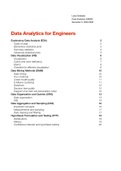Summary
Summary Data Analytics for Engineers (2IAB0) 2020/2021
- Course
- Institution
This summary consists of all the theory given in the lectures of the Data Analytics for Engineers course. Additionally, it also consists of examples to help you understand the subject matter. This summary will provide you with the necessary basics for the exam!
[Show more]



